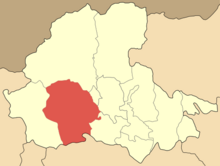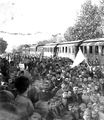إذيسا
إذيسا
Έδεσσα | |
|---|---|
 شلال إذِسا | |
| الإحداثيات: 40°48′N 22°3′E / 40.800°N 22.050°E | |
| البلد | |
| المنطقة الادارية | مقدونيا الوسطى |
| الوحدة المحلية | پـِلاّ |
| المقاطعات | 15 |
| الحكومة | |
| • العمدة | Dimitris Giannou (ND; منذ 2011) |
| المساحة | |
| • البلدية | 611٫212 كم² (235٫990 ميل²) |
| • الوحدة البلدية | 321٫2 كم² (124�0 ميل²) |
| المنسوب | 320 m (1٬050 ft) |
| التعداد (2011)[1] | |
| • الإجمالي | 18٬229 |
| • البلدية | 28٬814 |
| • كثافة البلدية | 47/km2 (120/sq mi) |
| • الوحدة البلدية | 25٬179 |
| • كثافة الوحدة البلدية | 78/km2 (200/sq mi) |
| Community | |
| • التعداد | 19٬036 (2011) |
| منطقة التوقيت | UTC+2 (EET) |
| • الصيف (التوقيت الصيفي) | UTC+3 (EEST) |
| Postal code | 582 00 |
| مفتاح الهاتف | 23810 |
| Vehicle registration | ΕΕ |
| الموقع الإلكتروني | dimosedessas.gov.gr |
إذِسـّا : (باليونانية: Έδεσσα)، (بالإنجليزية: Edessa)، (بالمقدونية: Vodena)، مدينة يونانية تقع في شمال البلاد ضمن منطقة مقدونيا الوسطى الإدارية، وهي مركز مقاطعة بيلا ضمن هذه المنطقة الإدارية.
الموقع، السكان والتسمية
تقع المدينة على ارتفاع 320 م عن مستوى سطح البحر، ضمن هضبة شبه دائرية الشكل على قمة جرف شديد الانحدار ذو طبيعة كلسية مطلةً من الشرق على سهل أكسيوس، تمر عبر المدينة مياه نهر إذيسوس التي تشكل شلالات مرتفعة عند وصولها للمنحدر الكلسي، تعتبر هذه الشلالات من أهم وأعلى الشلالات مسقطاً في اليونان.
تبعد إذيسا مسافة 80 كيلومتر إلى الشمال الغربي من سالونيك، 526 كيلومتر عن أثينا، و حوالي 53 كيلومتر عن الحدود المقدونية.
يعتقد أن اسم المدينة له أصول إلليرية، وقد تم إطلاق نفس اسم المدينة لاحقاً من قبل سلوقس الأول على مدينة الرها التي تقع حالياً في تركيا وتعرف باسمها التركي شانلورفا. وتعرف المدينة باسمها السلافي الآخر فودينا (Vodena)، والذي يعني الوفرة في المياه وذلك من الجذر فودا (Voda) والذي يعني المياه باللغات السلافية.
يبلغ عدد سكان المدينة حوالي 25 ألف نسمة.
التاريخ
وجدت آثار تعود للفترة الكلاسيكية والرومانية لمدينة إذيسا القديمة أسفل المنحدر الذي تقع فوقه المدينة الحالية وهذه الآثار مؤلفة من جدران،أغورا و مجموعة من الأعمدة، حيث كانت هذه المدينة تملك وقتها أهمية معينة بسبب وجودها على طريق إغناتيا وخاصة في القرون الأولى للميلاد. وكان لها بين عامي 27 ق.م. و 249 م. نقودها الخاصة.
عرف القليل عن تاريخ المدينة بعد عام 500 م. عندما بدأ الاستيطان السلافي فيها واستمر حتى القرن الثامن م. حيث اختفى اسم (إذيسا) وأصبحت المدينة معروفة باسم (فودينا). ذكرها الإمبراطور والمؤرخ البيزنطي جون السادس كانتاكوزينوس عام 1340 م. عندما حاول محاصرتها واستعادتها من الصرب.

| |
| O: laureate draped and cuirassed bust | R: Roma seated on shield holding Nike with wreath and palm and parazonium is crowned with a wreath by Tyche holding cornucopia standing behind
ΕΔΕϹϹΑΙΩΝ / ΟΜΟΝΟΙ / Α |
| bronze coin struck by Philip the Arab in Edessa 244-249 AD; ref.: Moushmov 6277 Plate XLIV 21 | |
Little is known about the fate of the city after 500 AD, but we know that its Greek bishop, Isidoros, participated in the Ecumenical Council of 692.
The city disappears from the sources thereafter, and re-emerges only in the 11th century, in the account of the Bulgarian wars of Emperor Basil II by the chronicler John Skylitzes, with the Slavic name Vodena (τὰ Βοδηνά in Greek).[2] The Bulgarian historian Vasil Zlatarski hypothesized that it was Vodena, and not Vidin on the Danube, that was a base of the Cometopuli in their revolt against Byzantium.[2]
Due to its strategic location, controlling the Via Egnatia as it enters the Pindus mountains, the town was much fought over in the subsequent centuries: the Normans under Bohemond I captured it briefly in 1083, but were eventually repelled by the forces of Emperor Alexios I Komnenos. The Nicaean emperor John III Vatatzes captured in 1253, while in the mid-14th century its possession was disputed between the Byzantines and the Serbs under Stephen Dushan, with the latter securing its possession in January 1351.[2] The city was for some time under control of Radoslav Hlapen, who gave it as dowry to his son-in-law Nikola Bagaš probably around 1366/7.[3] The city remained in Bagaš's hands at least until 1385.[4] It was conquered by the Ottoman commander Evrenos Bey in the late 14th century, along with the rest of Macedonia.[2] In 1519 (Hijri 925) the town had 68 Muslim and 116 Christian households; it was a joint zeamet of Murad of İpek, and Hüseyin the son of dizdar.[5]
استولى عليها العثمانيون عام 1390 م. مع باقي مناطق مقدونيا.
After almost 500 years of Ottoman rule, Edessa was annexed by Greece on 18 October 1912 during the First Balkan War, following the Hellenic Army's military victory against the Ottomans in the battle of Sarantaporo. At that time, Edessa was already well on its way to becoming a major industrial center in Macedonia. Four large textile factories with the Hemp Factory[6] being the biggest, employing the abundant waterfalls as a source of energy. Prior to World War I, in addition to Greeks, the region of Edessa was also populated by Turks, Bulgarians, Pomaks and Vlachs, but during the population exchange between Greece and Turkey most of the Turks and Pomaks living in Edessa were transferred to Turkey. Large numbers of Greek refugees from Asia Minor were settled in the area in 1923. The population swelled from 9,441 to 13,115 in the 1920s. A large segment of the population specialized in silk production, allowing Edessa to enjoy a high standard of living in the interwar period (1922–1940).
The town suffered during the last days of German occupation of Greece in 1944. As a retaliation for the shooting of one soldier by resistance fighters, the Nazis set Edessa on fire. Half of the city, including the Cathedral and the First Primary School, was destroyed and thousands of people were left homeless.
سكنت في المدينة جالية سلافية كبيرة خلال الفترة العثمانية، وكانت مركزاً للناشطين البلغار، دخلتها القوات اليونانية في تشرين الأول/أكتوبر عام 1912. سرعان ما أصبحت المدينة مركزاً صناعياً هاماً في مقدونيا على الرغم من قلة عدد سكانها في فترة ما بين الحربين العالميتين، وذلك بسبب وجود الطاقة المائية لتشغيل المصانع، وخاصة مصانع النسيج.
احتلتها القوات الألمانية والبلغارية أثناء الحرب العالمية الثانية والتي قامت بتدمير نصف المدينة انتقاماً من المقاومة. بعد انتهاء الحرب تراجعت أهمية المدينة كمركز صناعي وبرزت كمركز إداري لمقاطعة بيلا. During the Greek Civil War (1946-1949) Edessa was twice attacked in 1948 by the Democratic Army of Greece (DSE), under the control of the Communist Party of Greece. The Slavic-Macedonian National Liberation Front (SNOF), later simply the National Liberation Front (NOF) was heavily established in the area, with eleven Slav Macedonian partisan units operating in the mountains around the city.[7][8] When the NOF merged with the Democratic Army of Greece (DSE), many Slav Macedonians in the region enlisted as volunteers in the DSE.[9] In early 1949, the military forces of the Greek Government conducted a series of successful military operations that destroyed all communist forces and after the end of war in August 1949, many communists and sympathizers, both ethnic Greeks and Slav Macedonians were expelled from Greece and fled to the countries of Eastern Europe.[10]
Since the 1970s Edessa's economy no longer relies on industry. At the beginning of the 21st century, it is a city based on services (mostly linked to its function as capital of the Pella regional unit) and tourism due to the many ancient sights nearby, including ancient Pella, the waterfalls and winter sports.
المعالم الأساسية
- حي فاروسي (Varosi): وتوجد فيه العديد من المنازل المرممة والتي تعود للفترة العثمانية وبعض مصانع النسيج.
- الجامع الجديد (Yeni Cami) وبرج الساعة العثماني: ويعودان للفترة العثمانية المتأخرة، ويستخدم مبنى الجامع حالياً كمتحف أركيولوجي.
- أسوار المدينة القروسيطية: وهي تعود للفترة البيزنطية وتلاحظ في أجزاء عديدة من المدينة.
- مياه وشلالات إذيسوس: وهي أشهر معالم المدينة حيث تسقط المياه عبر الجرف الصخري من المدينة الجديدة إلى موقع المدينة القديمة مسافة 24 متر، حوّل المكان إلى حديقة عامة، يوجد خلف الشلالات كهف مع صواعد ونوازل.
- إذيسا القديمة: وأهم ما فيها دير أغيا ترياذا (Aghia Triada) التي تحتوي عناصر معمارية تعود للفترة الرومانية والبيزنطية، أعمدة أيونية تعود للفترة الكلاسيكية، يقايا بازيليك تعود للفترة المسيحية المبكرة.
Demographics
| Historical populations | |||
|---|---|---|---|
| (Statistics, 1913-2001) | |||
| Year | Town | Municipal unit | Municipality |
| 1913 | 8,846 | - | - |
| 1920 | 9,441 | - | - |
| 1928 | 13,115 | - | - |
| 1940 | 12,000[11] | - | - |
| 1951 | 14,940 | - | - |
| 1961 | 15,534 | - | - |
| 1971 | 13,967 | - | - |
| 1981 | 16,642 | - | - |
| 1991 | 17,659 | 25,051 | - |
| 2001 | 18,253 | 25,619 | - |
| 2011 | 19,036 | 25,179 | 28,814 |
Infrastructure
Transportation
Edessa railway station is located on the Thessaloniki–Bitola railway and is served by both InterCity trains and Proastiakos Thessaloniki suburban trains.
Media
متفرقات
- تعتبر إذيسا من المصايف المشهورة وطنياً، فهي تملك موقعاً مطلاً على أكثر مناطق مقدونيا الطبيعية جمالاً من كل الجهات.
- توجد في المدينة بعض أقسام جامعة مقدونيا.
- أهم نادي كرة قدم في المدينة هو إذيسايكوس إذيسا.
المدن الشقيقة
المعرض
Crowd celebrating the liberation of Edessa (First Balkan War)
View of the old Kanavourgeio (cannabis factory)
انظر أيضاً
- List of settlements in the Pella regional unit
- Edessa Ecclesiastical Museum
- Folklore Museum of Edessa
الهامش
- ^ أ ب "Απογραφή Πληθυσμού - Κατοικιών 2011. ΜΟΝΙΜΟΣ Πληθυσμός" (in اليونانية). Hellenic Statistical Authority.
- ^ أ ب ت ث Browning, Robert; Kazhdan, Alexander (1991). "Vodena". In Kazhdan, Alexander (ed.). The Oxford Dictionary of Byzantium. Oxford and New York: Oxford University Press. p. 2185. ISBN 978-0-19-504652-6.
- ^ Зборник радова Византолошког института. Научно дело. 1987. p. 219.
... свакако пре 1366/7 ...указана је могућност да га је Хлапен одмах након тога уступио Николи Багашу, ожењеном једном од његвих кћери..
- ^ Зборник радова Византолошког института. Научно дело. 1987. p. 164.
- ^ GÖKBİLGİN, M. TAYYİB (1956). "KANUNÎ SULTAN SÜLEYMAN DEVRİ BAŞLARINDA RUMELİ EYALETİ, LİVALARI, ŞEHİR VE KASABALARI". Belleten. 20 (78): 264. eISSN 2791-6472. ISSN 0041-4255.
- ^ "Old Hemp of Edessa (Artspace Culture & Industrial Museum)". youingreece.com. Retrieved 2018-10-20.
- ^ "Les Archives de la Macedoine, Fond: Aegean Macedonia in NLW" - (Field report of Mihail Keramidzhiev to the Main Command of NOF), 8 July 1945
- ^ Simpson, Neil (1994). Macedonia Its Disputed History. Victoria: Aristoc Press, 105,106 & 94. ISBN 0-646-20462-9.
- ^ Η Τραγική αναμέτρηση, 1945-1949 – Ο μύθος και η αλήθεια. Ζαούσης Αλέξανδρος" (ISBN 9607213432).
- ^ Simpson, Neil (1994). Macedonia Its Disputed History. Victoria: Aristoc Press, 101,102 & 91. ISBN 0-646-20462-9.
- ^ "Edessa - 3000 years history". Edessacity.gr. Retrieved 2013-03-26.
للاستزادة
- F. Papazoglou, Les villes de Macédoine romaine (The Cities of Roman Macedonia), BCH Suppl. 16, 1988, 127-131.
- Walter Bauer, Orthodoxy and Heresy in Earliest Christianity, 1934, (in English 1971) (On-line text)
وصلات خارجية
- Edessa official site
- Infosite about Edessa
- Pella regional unit official site, containing useful information about Edessa
- Hellenic Ministry of Culture: Old Cathedral of Edessa
 Chisholm, Hugh, ed. (1911). . دائرة المعارف البريطانية. Vol. 8 (eleventh ed.). Cambridge University Press. p. 929.
Chisholm, Hugh, ed. (1911). . دائرة المعارف البريطانية. Vol. 8 (eleventh ed.). Cambridge University Press. p. 929. {{cite encyclopedia}}: Cite has empty unknown parameter:|coauthors=(help)
- Pages using gadget WikiMiniAtlas
- CS1 اليونانية-language sources (el)
- Short description is different from Wikidata
- Coordinates on Wikidata
- Articles containing Ancient Greek (to 1453)-language text
- مقالات المعرفة المحتوية على معلومات من دائرة المعارف البريطانية طبعة 1911
- عواصم مقاطعات اليونان
- Bottiaea
- Municipalities of Central Macedonia
- Edessa, Greece
- Archaeological sites in Macedonia (Greece)
- مدن اليونان


















